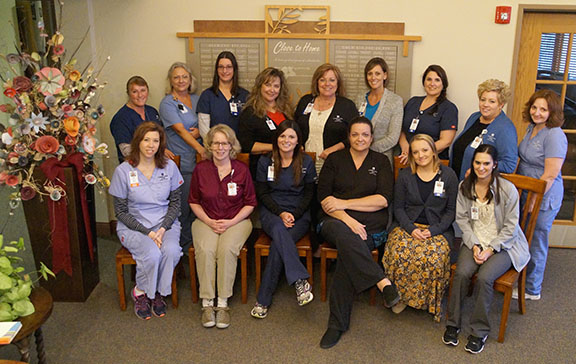November 2016 Department Discovery: Home Health and Hospice
- Posted On:
- Written By: Felicia Messimer

The November Department Discovery shines a light on Campbell County Health’s Home Health and Hospice.
Home Health and Hospice, according to Director Maureen Hurley, are two different departments operated by a highly skilled team of 31 who offer a wide array of services.
From wound care to IV infusions and medication education to physical therapy, CCH’s Home Health brings skilled care right to the patient’s home.
“In home health, we do a lot of disease management, teaching and post-operative care,” Maureen said. “We are in there to educate and help the family set up a plan to be successful. It gives us the opportunity to build some strong relationships with our patients in their own environment.”
Home Health provides care to patients at home—where they receive support from trained medical professionals, family, friends, plus the comfort of familiar surroundings. Regardless of age, everyone appreciates the comfort and convenience of recovery in their home as an alternative to hospitalization or a nursing home. Home healthcare may also mean earlier discharge from the hospital, and lower healthcare costs. It is a personalized form of care, which may be paid by Medicare, Medicaid, private insurance, or directly by the patient.
“It’s a very diverse level of nursing care,” Maureen, RN, CHPN, said. “It often becomes a more intimate care experience. We are visitors in someone’s home and the dynamics are very different.”
CCH added Hospice services to the home health program in 2003. “End of life care is such a valuable part of healthcare,” Maureen said. “We can provide many services to our patients and families who are dealing with a life-limiting illness.”
Hospice is a special kind of care for people with life-limiting illnesses. Helping patients physically, emotionally and spiritually is the focus of CCH Hospice as they help patients with end of life care.
“In Hospice, the patient and family are both our clients,” said Melisa Haddix, social service and bereavement coordinator at CCH Home Health and Hospice. “They’re both part of our unit of care. We follow the primary caregiver for 13 months after the patient dies.”
When a patient first chooses Hospice care, the Hospice team discusses with the patient about what their understanding of the illness is.
“People have a lot of myths and misconceptions about Hospice care,” Melisa said. “It’s a big decision for people because it’s palliative care. It’s not curative.”
That means for the patients, there will be no discussions about the next treatment or more options to cure whatever disease or ailment that has brought them to that point. The discussion turns to what they want their end of life care to look like and how they can enjoy the highest quality of life for the time remaining. Some of the most basic caregiving begins with pain management for the patient and then slowly addressing the patient’s additional needs. From helping patients get connected to spiritual leaders to just spending time talking about life, the Hospice team is there to assist the patient and their family as much as possible.
“In social services, we look at all the non-physical things that are making them not comfortable,” Melisa said. “Finances are always a concern for someone who’s dying. We want to make sure spiritually they get what they need and want.”
If there are certain things that a patient wants from having a special dinner to celebrating Christmas and enjoying a family gathering to watching a special movie, the Hospice team tries to make those wishes happen. Some of the biggest assistance Hospice provides is being a neutral party between the patients and their family.
“We help a lot with communication and mediation with family members,” Melisa said. “We’re going to talk about the hard discussions in a kind, compassionate way. Ultimately, it’s so the patient can be as peaceful as they can be at the time of their death.”
Each day the team at Hospice, from those who clean the rooms to the doctors and nurses, works to help every second count for the patients they care for. Although the Close to Home Hospice Hospitality House is most visible, the majority of Hospice patients receive care wherever they call home, which could be from the comfort of their home, a relative’s home, or The Legacy Living and Rehabilitation Center for example.
Throughout the year, the departments invite you to honor a loved one who has passed away by writing them a message on a memorial bloom—artfully printed flat scrap-booking paper that can be written and drawn on by someone who wishes to memorialize an individual for a donation. Hospice volunteers turn your memory sheet into a beautiful flower to be displayed in the hospice house for the next year. Learn more at www.cchwyo.org/blooms.
Please join us at the Service of Memory and Hope on Monday, November 21 at 6 pm at the First Presbyterian Church, 511 Carey Avenue. This event gives those in grief a chance to remember and celebrate loved ones who have passed away. Learn more at www.cchwyo.org/hope.
Maureen said she hopes that all families will reach out for assistance when needed, whether that’s for home health or hospice. Servicing all of Campbell County and parts of Crook County, home health and hospice serve patients near and far.
For those who don’t know, November is National Hospice and Palliative Care Month. Hospice brings you and your family high-quality, compassionate care when a cure is not possible. A big round of applause to CCH’s Home Health and Hospice team! Thank you for all that you do. You can learn more about Home Health and Hospice at www.cchwyo.org/hhh.
